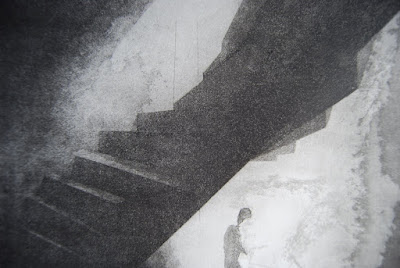29 April 2010
black mill
black mill is a short film, which supports my masters thesis in architecture. it is a film based on the film noir genre; a detective story set in a derelict building on the outskirts of dundee city centre.
in this film i investigate qualities of natural, incidental light and methods of representation with the video medium. with this production i was particularly interested to experiment with ideas of cinematography, such as video collage, time-delayed overlays and 'panning through walls'. the film was a collaborative project with fellow student of architecture, stephen mackie. stephen acts as the detective.
having completed this project, the film is, for me, somewhere between a building survey and an architectural proposition. the existing ruinous qualities of the old mill are catalogued, inseparable from an entirely subjective, [although at points hyper-real] experience of spaces.
this film runs for 15mins it has been split in two parts, as below
both parts, amongst other short films of mine, can be found on my youtube channel
headphones are advised
"of darkness visible so much be lent,
as half to show, half veil the deep intent"
[ alexander pope, 1943, dunciad, book IV, the poems of a. pope]
▪▪▪
28 April 2010
"the divine light penetrates the universe according to its dignity"
[dante, c.1300, the divine comedy]
the following sketch is of 'room 55985;' the chamber where solaris is to be played. drawn with a lithograph crayon, the image is an attempt to represent the curvature of the inner surface of a sphere, with multiple point-perspective field of view. the viewer/camera is somewhere above this one punctual spectator, not quite in the centre of the apparent sphere, looking down onto the top of this column.
within the body of the column are two concentric spiral staircases - rotating against each other. one to reach this privileged position, the other to leave.
'black 55985' is the name of etching ink used to print this plate. this black is particularly dark, with an imperceivable brown hue.
08:57 16th july 2186
geo. latitude 4° 38' n
geo. longitude 74° 05' w
julian date 206
declination -11.6029
hour angle [at 09:00] 45°
2186 is not a leap year
for further explanation, derivatives and equations see here
▪▪▪
17 April 2010

my design proposal is essentially a giant optical instrument carved into the side of a mountain.
somewhere between astronomical observatory and epic cinema theatre, the form of this design is finely tuned to a rare total solar eclipse.
part of the intention is to explore the periphery of our vision, not just our field of view, but also our range of contrasts, our limits of luminescent perception, pure white and absolute black, our ability to project image, as well as receive. ask the question 'how can this affect space?'
part of the intention is to bring into close relationship the scales at which light affects us; on one hand, the sun illuminates over half our planet with a blinding 90,000 lux from 149,600,000,000 metres, whereas the human eye can adapt to use just 1 lux of light, as from the full moon close to the equator.
image: sketchbook entry for matzine#004. image was experiment in expanding the field of view to include the implausible. you are both behind and in front of a wall.
_
▪▪▪
16 April 2010
-a-
monumental
subterranean
optical
instrument
-for-
showing
tarkovsky's
solaris
-on-
sixteenth
july
twenty
one
eighty
six
-at-
nine
fourty
two
a
m
"light gives of itself freely, filling all available space. it does not seek anything in return; it asks not whether you are friend or foe. it gives of itself and is not thereby diminished"
[michael strassfeld]
"it seemed to be a necessary ritual that he should prepare himself for sleep by meditating under the solemnity of the night sky... a mysterious transaction between the infinity of the soul and the infinity of the universe"
[victor hugo, les misérables, 1982, p67]
image: contour-collage of site and entrance
▪▪▪
15 April 2010
"the obscurity of a "mystery" comes from images that a kind of lucid dream borrows from the realm of the crowd, sometimes bringing to light what the guilty conscience has pushed back into the shadows, sometimes highlighting figures that are routinely ignored"
[georges bataille, 1985, visions of excess: selected writings, 1927-1939, university of minnesota press, p213]
my latest print is the engine room of my design proposition
from here, extremely long and thin vents channel direct sunlight deep into the heart of the mountain, for processing. this light needs to be measured, controlled, timed and otherwise heavily manipulated before it reaches the screen.
concentrated, the intensity of this light would blind you.
▪▪▪
5 April 2010
1, 3 scotopia, 2 trajan's seat
it is time for a point of departure in my work.
a written segment of my thesis is in existence.
existing drawings are being re-evaluated.
fresh drawings are riding that edge of nothingness,
the event horizon.
light is something you can’t touch,
you can’t see it,
move it
or weigh it.
light doesn’t need air.
in the morning,
light visits distant planets
and bounces back to earth,
before you boil your kettle.
and light can travel-time.
if I ask the question ‘what is light?’ my immediate response, as a student of architecture, would be to find an answer here: “architecture is the masterly, correct and magnificent play of masses brought together in light” [le corbusier, 1927] but in fact this answer seems to have dodged the question entirely.
▪▪▪
4 April 2010
matzine #004
the sketchbook edition
[you might find a mirror useful]
[also, mackinnon-pryde does a good job of explaining what a zine is]
_
▪▪▪











